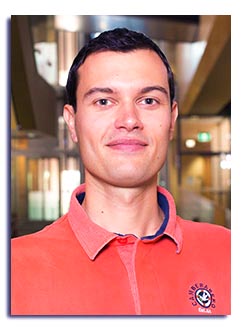
Abstract
Cu2ZnSn(S,Se)4 (CZTSSe), interesting absorber material for thin-film solar cells, is subject to disorder by Cu-Zn exchanges.
We used spectrophotometry (SP) to investigate the order-disorder transition in pure selenide CZTSe thin film. A single sample was annealed/quenched several times with varying dwell temperature to modify the degree of disorder which changes the band gap by 110 meV. The comparison of band gap evolution during the annealing/quenching sequence and the evolution of the long-range order parameter clearly revealed that the band gap can be used as a secondary order parameter. We find the critical temperature for CZTSe order-disorder transition at 200°C.
CZTSSe is subject to significant band tailing to which the large open-circuit voltage (VOC) deficit can be attributed. The VOC deficit, observed unanimously for CZTSSe solar cells, is the current bottleneck to further improvement of the photovoltaic properties of this material. The tails are caused by disorder in the crystal: electrostatic potential fluctuations caused by compensating defects or band gap fluctuations. To study the nature of the band tails we performed temperature and intensity dependent photoluminescence (PL) studies in CZTSSe absorbers. The tails are mostly due to band gap fluctuations and only to a smaller degree to electrostatic fluctuations. Since the degree of disorder has a significant influence on the band gap, it could be assumed that Cu-Zn disorder is responsible for the tails. We measured the optical absorption in Se-rich CZTSSe and pure selenide CZTSe samples with different Cu-Zn ordering degrees. SP and PL were used to access a wide range of the absorption coefficient values. Especially PL, which is a powerful method to investigate band-tail and defect induced absorption, was able to provide accurate measurements of the tail-induced low absorption. We find Urbach tail behaviour that reaches deep into the band gap. The comparison of the absorption spectra did not reveal any differences in terms of band tailing for fully disordered CZTSSe and partially ordered CZTSSe, despite the effort in reaching high degree of order. The Zn-Cu disorder does not appear as the main cause of the tailing in CZTSSe. In agreement, we find that reducing the degree of Cu-Zn disorder do not lead to improvement of the open circuit voltage deficit indicating that Zn-Cu disorder related defects are not the main limiting factor of CZTSSe solar cells.
Click here to see all available video seminars.
Click here to go to the SPREE HOMEPAGE.
Brief Bio
Germain Rey studied Physics at the University Joseph Fourier in Grenoble. He obtained his PhD in Material science at the University of Grenoble in 2012. where he was studying nanostructured metallic oxides (zinc oxide and fluorine doped tin oxide) as photoanode materials or transparent conductive oxide in dye sensitized solar cells. He worked a few years as research associate at the University of Luxembourg in the field of CZTSe thin-film solar cells, with interest in Cu-Zn disorder. In September 2018 he moved to UNSW where he now works as a postdoctoral fellow in the PL group, developing PL imaging on thin-film solar cells.
